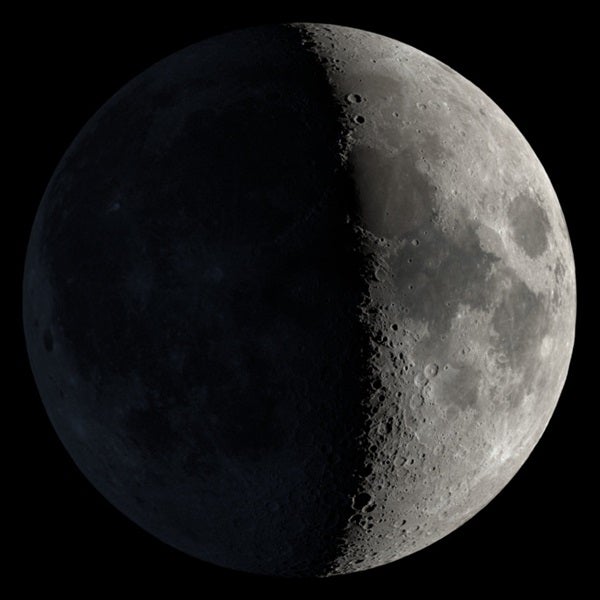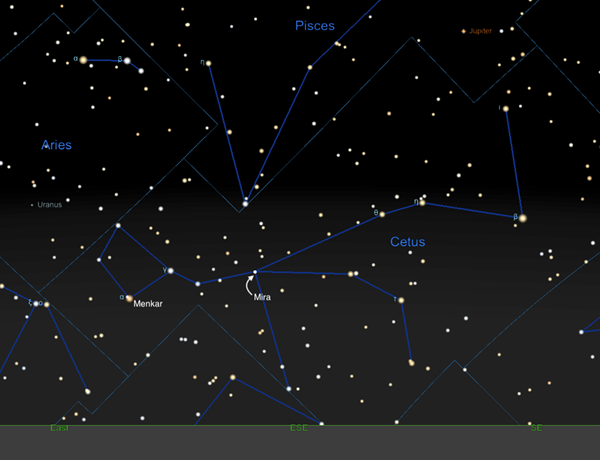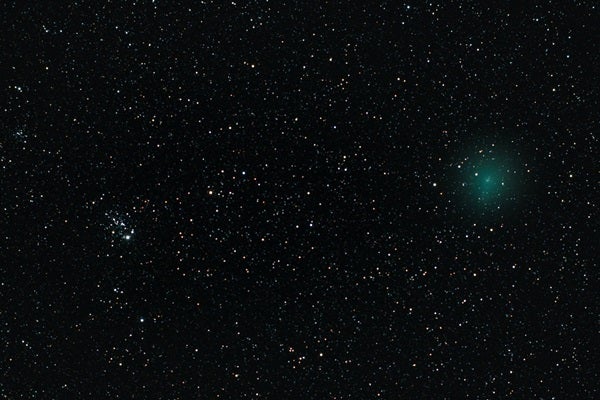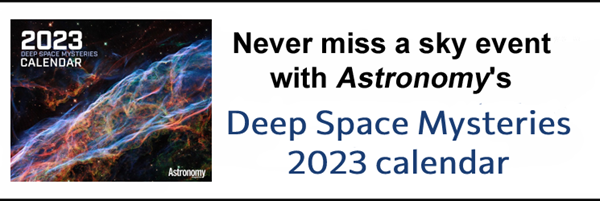Friday, September 30
Asteroid 4 Vesta lies near M30, a densely packed globular cluster in the constellation Capricornus, tonight. The main-belt world is currently magnitude 6.7, which you can easily net with binoculars or a small scope. Similarly, M30 glows at magnitude 7.2, only a smidge fainter.
To find them, look south after sunset; two hours after the Sun disappears, Capricornus is roughly 30° high. Vesta sits in its far southeast corner, about 6.7° below 3rd-magnitude Deneb Algedi. M30 is just 3° due west of Vesta, easy to get within the same binocular (or finder scope) field of view.
Also in Capricornus is mighty Saturn, which glows at magnitude 0.3. The ringed planet is 5° west of Deneb Algedi and 1° east of 4th-magnitude Iota (ι) Capricorni. Through a telescope, its disk stretches 18″ across, while its rings span some 42″ along their long axis. Look also for magnitude 8.5 Titan, which sits about 1′ to Saturn’s southwest tonight.
Sunrise: 6:55 A.M.
Sunset: 6:44 P.M.
Moonrise: 12:11 P.M.
Moonset: 9:34 P.M.
Moon Phase: Waxing crescent (25%)
*Times for sunrise, sunset, moonrise, and moonset are given in local time from 40° N 90° W. The Moon’s illumination is given at 12 P.M. local time from the same location.
Saturday, October 1
Mercury ends its retrograde motion and stands stationary against the background stars at 11 A.M. EDT. The small planet is visible starting about an hour before sunrise in the east, slowly rising higher as the sky brightens. It’s currently magnitude 0.9 but will brighten significantly in the coming weeks. If you do seek it out before dawn, make sure to stop using any telescopes, binoculars, or other optics several minutes before the Sun is due to rise from your location.
Tonight is International Observe the Moon Night. According to NASA, roughly half a million people in more than 100 countries participated in observing Earth’s only natural satellite last year. Lend your eyes to the effort this year starting in the afternoon, when the Moon rises in the southeast.
Luna is about 20° high in the south at sunset. It’s currently a waxing crescent some 40 percent lit, located in far southern Ophiuchus. There’s plenty to explore in the lit region of the Moon this evening, including the seas of Serenity, Tranquillity, Crises, and Fertility. Look also along the terminator separating lunar night and day, where craters, mountains, and other features stand out the most.
Sunrise: 6:56 A.M.
Sunset: 6:42 P.M.
Moonrise: 1:24 P.M.
Moonset: 10:23 P.M.
Moon Phase: Waxing crescent (35%)
Sunday, October 2
First Quarter Moon occurs at 8:14 P.M. EDT today. The Moon is now in Sagittarius, floating amid the stars of its famous Teapot asterism.
Above Sagittarius is Aquila, which contains the famous luminary Altair. Shining at magnitude 0.8, it is the 12th-brightest star in the sky and part of the Summer Triangle with its fellow stars Deneb in Cygnus and Vega in Lyra. You’ll notice this large asterism stays relatively low in the sky these days, now that fall has arrived.
Look to the lower left and upper right (southeast and northwest, respectively) of Altair and you’ll see magnitude 3.7 Beta (β) and magnitude 2.7 Gamma (γ) Aquilae. Together with Altair in the center, this pattern might remind you of a bird with its wings outstretched, appropriate for the Eagle constellation. According to stellar expert Jim Kaler, these three bright, close-together stars are sometimes mistaken for an airplane and its wing lights!
Sunrise: 6:57 A.M.
Sunset: 6:40 P.M.
Moonrise: 2:29 P.M.
Moonset: 11:24 P.M.
Moon Phase: Waxing crescent (47%)
Monday, October 3
The American Association of Variable Star Observers’ monthly featured variable star for October is a particularly famous one: Mira (Omicron [ο] Ceti) in Cetus the Whale.
Cetus rises in the east a few hours after the Sun sets. By about 10 P.M. local time, the full constellation should sit above the horizon. Magnitude 2.5 Menkar, Cetus’ alpha star, is about 12° high. Mira sits another 12° to its upper right (southwest). This star’s name was bestowed upon it in the mid-1600s by Polish astronomer Johannes Hevelius; the word translates to wonderful. It is the archetypical Mira variable, a type of variable star with a period of about a year. Over the course of 332 days, Mira can shine as bright as 2nd magnitude and as faint as 10th magnitude, essentially disappearing and reappearing to the naked eye!
So, that’s the question for you to answer tonight: Can you see Mira without optical aid or do you need binoculars or a telescope to glimpse its light? Check the chart above for its relative location in this region of the sky.
Sunrise: 6:58 A.M.
Sunset: 6:39 P.M.
Moonrise: 3:27 P.M.
Moonset: —
Moon Phase: Waxing gibbous (58%)
Tuesday, October 4
The Moon reaches perigee, the closest point to Earth in its slightly oblong orbit, at 12:34 P.M. EDT. At that time, it will sit 229,488 miles (369,325 kilometers) away.
Jupiter still dominates the nighttime sky, only days after reaching opposition last week. It’s up all night and, at magnitude –2.9, it’s still just as bright. The solar system’s largest planet lies in southern Pisces the Fish, where there are few bright stars and the planet really stands out.
Zoom in with your telescope to look for its alternating light and dark bands of clouds. Jupiter’s mighty disk spans 50″, offering a wealth of detail. You should also see its four Galilean moons: Io sits alone to the west, while Ganymede, Europa, and Callisto stand to the east, in that order from nearest to farthest from the planet. If you’re able to watch overnight and into the early-morning hours, Ganymede will draw closer to the limb and cross onto the disk in a transit around 3:20 A.M. EDT on the 5th.
Sunrise: 6:59 A.M.
Sunset: 6:37 P.M.
Moonrise: 4:14 P.M.
Moonset: 12:34 A.M.
Moon Phase: Waxing gibbous (69%)
Wednesday, October 5
The Moon passes 4° south of Saturn at 12 P.M. EDT. An hour after sunset, you can find the pair in the south; our satellite now sits just over 6° southeast (to the lower left) of Saturn.
With the Moon quickly nearing Full, let’s turn our gaze to the other side of the sky to avoid its light. In the north, the distinctive W of Cassiopeia sits to the right of the North Star. Delta (δ) Cassiopeiae marks the first dip or valley in that W, as read from left to right. Our target is the open cluster NGC 457, often called the Owl Cluster, which sits 2° south of magnitude 2.7 Delta.
Spanning some 20′ and shining with a combined magnitude of 6.4, this group of young stars resembles an owl with its wings outspread. (Alternatively, some call it the E.T. cluster, saying it looks like the familiar alien with his arms wide.) Quite noticeable are the figure’s two bright eyes, marked by magnitude 5 Phi (ϕ) Cassiopeiae and magnitude 7 HD 7902. Phi, however, does not seem to be a cluster member — instead, it lies in the foreground, between Earth and the more distant cluster stars.
Sunrise: 7:00 A.M.
Sunset: 6:36 P.M.
Moonrise: 4:52 P.M.
Moonset: 1:49 A.M.
Moon Phase: Waxing gibbous (79%)
Thursday, October 6
Mercury is now magnitude –0.1 in the morning sky, rising some 90 minutes before the Sun. About 40 minutes before sunrise, look for the planet about 3° above the eastern horizon, sitting beneath the fading constellation Leo. Can you make out the Lion’s bright alpha and beta stars, Regulus and Denebola, respectively? Regulus (magnitude 1.4) marks Leo’s heart, while Denebola (magnitude 2.1) sits at the end of his tail. To Leo’s upper left, the stars of the Big Dipper may also be visible in the growing twilight, though they’ll disappear quickly as the sky continues to brighten.
Through a telescope, Mercury now appears 7″ across and is just over 40 percent lit. In just a few days, it will reach its greatest eastern elongation from the Sun, then quickly begin moving back toward our star, sinking in the morning sky as it brightens.
Sunrise: 7:01 A.M.
Sunset: 6:34 P.M.
Moonrise: 5:24 P.M.
Moonset: 3:04 A.M.
Moon Phase: Waxing gibbous (88%)
Friday, October 7
Asteroid 4 Vesta is stationary against the background stars of Capricornus at 2 A.M. EDT this morning. It will now begin moving northeast, slowly pulling away from its current position and sliding toward Aquarius.
Continuing across the sky, the nearly Full Moon passes 3° south of Neptune at 11 P.M. EDT. You’ll find them in far northeastern Aquarius, near the constellation’s border with Pisces. Neptune is the most distant solar system planet, appearing as a faint magnitude 7.7 dot. You’ll need binoculars or a telescope to see it, and picking it out may be difficult with the Moon’s bright background light. Look for a “flat” star 3° above the Moon in the sky and about 1.5° east of a small triangle of 6th- to 7th-magnitude stars. The dim planet’s disk spans just 2″ at its vast distance of nearly 2.7 billion miles (4.3 billion km) from Earth.
Sunrise: 7:02 A.M.
Sunset: 6:32 P.M.
Moonrise: 5:51 P.M.
Moonset: 4:18 A.M.
Moon Phase: Waxing gibbous (94%)













